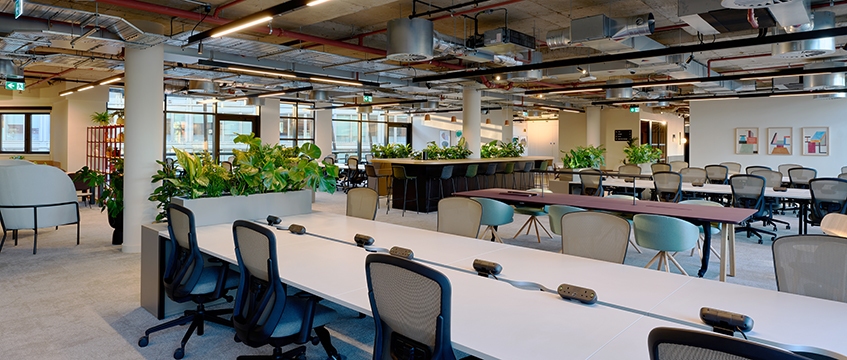London office refurbs rise but market faces supply shortage
Office owners in the capital are pushing ahead with a drive to ensure they are not left holding stranded assets – but a slowdown in new starts looks set to mean the market still faces a medium-term supply shortage.
The latest biannual London Crane Survey from accountancy firm Deloitte tracked 36 new schemes starting over the six months to March, up from the long-term average of 27. But almost all – 31 – were refurbishment projects.
That left just five schemes as new-build starts, down by a third over six months and providing further evidence of the impact of inflation and soaring build costs.
Office owners in the capital are pushing ahead with a drive to ensure they are not left holding stranded assets – but a slowdown in new starts looks set to mean the market still faces a medium-term supply shortage.
The latest biannual London Crane Survey from accountancy firm Deloitte tracked 36 new schemes starting over the six months to March, up from the long-term average of 27. But almost all – 31 – were refurbishment projects.
That left just five schemes as new-build starts, down by a third over six months and providing further evidence of the impact of inflation and soaring build costs.
A crunch on costs will continue to hamper new-build starts unless developments and investment partners can navigate rising inflation, Mike Cracknell, real estate director at Deloitte, told EG.
“Last year we were talking in the survey about supply and demand imbalances that Covid had brought us,” he said. “Then you overlay that with the war in Ukraine, the impact on energy prices and energy-intensive components like steel and glass, which for the new-build buildings are a big component of the cost. We have been seeing quite a lot of pain in terms of the inflation pace in the near past.”
Post-pandemic navigation
The refurbishment and new-build projects over the six months spanned just 2.3m sq ft, down by a third and suggesting a supply shortage in the medium-term. If there is a silver lining, it is that this should support rental growth.
Across schemes that were either started during the six months or which were already under way, the volume of office construction stood at 13.5m, up by 4% from the previous survey and above the 10-year average. Completions this year are expected to hit 7m sq ft, the highest level in almost two decades. Two-thirds of developers questioned for the survey said they aim to grow their pipeline over the next six months.
Almost a third of the space under construction already has a tenant signed up, and developers are upbeat about the prelet and general leasing market. Two-thirds said demand was “a little better” than six months ago, and 14% said it was “much better”. But most acknowledged that continued hybrid working will ultimately dent demand– across all respondents, demand is expected to fall by 14% over the longer term. For now, uncertainty looks set to remain.
“During Covid it was a really difficult time if you had a lease break,” Cracknell said. “Quite a few people sought to extend their leases and push them out a bit further. Some of that pushing out will inevitably return. In terms of the leasing numbers, Q1 this year has been really quite strong. We think that most corporates are still working out, post-Covid, exactly how much space they want, trialling things.”
EPC pressures
The rise in refurbishment activity comes as an expected minimum requirement for energy performance certification nears – if, as anticipated, office blocks will need a minimum grade B rating by 2030, Deloitte noted, 80% of London stock will have to be upgraded. That’s about 15m sq ft a year.
“We are currently only pushing into the market about 5m sq ft,” Cracknell said. “Some of these are lesser requirements – you need to replace the lighting within the building or the major plant – but that’s still quite difficult to do with a sitting tenant. So there is a question mark. Can all that happen in the time period that’s available?”
Looming legislation is continuing to act as a wake-up call for owners, Cracknell added, although the smartest may find a good opportunity to pick up new projects.
“If you are the sort of landlord that’s just used to collecting the rent, you’re probably in for a bit of a shock,” he said. “The active, astute investor sees this precipice coming and says ‘here’s my opportunity to do something’. I guess the clever thing is to acquire some [assets] in the market that will fall foul of the legislation, but perhaps don’t need too much money spent to bring them up into where they need to be. The best of the stranded assets, you could recover.”
Recover, and perhaps repurpose. Shifts are already being seen in the make-up of the occupier market, said Margaret Doyle, chief insights officer for financial services and real estate at Deloitte, who pointed to London’s “evolution and resilience” over the course of the pandemic.
“The new kid on the block, to my mind, is life sciences,” Doyle said. “It’s not huge. It’s not like Google and Apple, gazillions of square feet. But whether it’s Canary Wharf and a 750,000 sq ft hub, or White City alongside the new Imperial College West Campus, there are a number of new developments where the life sciences piece [is apparent]. It’s not going to displace TMT or financial service tomorrow. But it speaks to the incredible creativity and resilience in London. London is showing, again and again, a capacity to reinvent itself.”
See how much space is being transacted by the top London agents >>
To send feedback, e-mail tim.burke@eg.co.uk or tweet @_tim_burke or @EGPropertyNews
Photo © London From The Rooftops/Bav Media/Shutterstock











